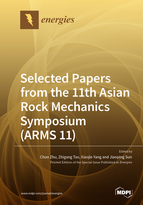Selected Papers from the 11th Asian Rock Mechanics Symposium (ARMS 11)
A special issue of Energies (ISSN 1996-1073). This special issue belongs to the section "H: Geo-Energy".
Deadline for manuscript submissions: closed (30 December 2021) | Viewed by 11561
Special Issue Editors
Interests: rock mechanics; geological hazard monitoring; surrounding rock support; slope stability
Special Issues, Collections and Topics in MDPI journals
Interests: rock mechanics; geological hazard monitoring; surrounding rock support; slope stability
Special Issues, Collections and Topics in MDPI journals
Interests: mining engineering; rock support
Interests: slope stability; seepage analysis; rock cavern design; ground improvement; retaining wall design
Special Issues, Collections and Topics in MDPI journals
Special Issue Information
Dear Colleagues,
The 11th Asian Rock Mechanics Symposium (ARMS 11) will be held in Beijing, China, October 21–25,2021. The theme for ARMS 11 is “Challenges and Opportunities in Rock Mechanics and Engineering”. The technical program will focus on advances and innovative applied research on rock mechanics and rock engineering. It will provide a showcase of recent developments and advances in rock mechanics and innovative applications in rock engineering. It will offer an international forum for exchanging new ideas and exploring the future directions in rock mechanics and engineering. Short courses, workshops, industrial exhibitions and technical visits will also be organized.
This Special Issue aims to provide an important contribution by presenting state-of-the-art knowledge with the relationship between rock mechanics and energy exploitation. Furthermore, we are particularly welcoming ARMS 11 papers that address new technology with underground energy exploitation. Topics include but are not limited to:
- Latest theory and method in rock mechanics;
- Laboratory and field testing techniques;
- Numerical methods in rock mechanics and numerical modeling;
- Rock engineering design;
- Field investigation and monitoring techniques;
- Rock dynamics;
- Soft rock engineering;
- Underground disposal of nuclear waste;
- Earthquake and geological disaster prevention and mitigation;
- Protection and reinforcement of ancient sites;
- Mining engineering;
- Tunnel and underground space;
- Rockslide and engineered slope;
- Carbon emission reduction and geological sequestration;
- Case studies for rock engineering;
- Reservoir geomechanics and geological environment effect;
- Rock burst and pressure bump;
- Clean energy development;
- New frontiers and interdisciplinary fields;
- Progress in geotechnical engineering information technology and its application;
- Geotechnical engineering technology;
- Challenges in rock mechanics in large-scale hydropower engineering;
- Karst engineering and rock soil anchoring and new technologies of grouting;
- Geo-energy engineering;
- Deformation, reinforcement and in situ stress measurement of coal mass.
Prof. Dr. Chun Zhu
Prof. Dr. Zhigang Tao
Prof. Dr. Xiaojie Yang
Dr. Jianping Sun
Guest Editors
Manuscript Submission Information
Manuscripts should be submitted online at www.mdpi.com by registering and logging in to this website. Once you are registered, click here to go to the submission form. Manuscripts can be submitted until the deadline. All submissions that pass pre-check are peer-reviewed. Accepted papers will be published continuously in the journal (as soon as accepted) and will be listed together on the special issue website. Research articles, review articles as well as short communications are invited. For planned papers, a title and short abstract (about 100 words) can be sent to the Editorial Office for announcement on this website.
Submitted manuscripts should not have been published previously, nor be under consideration for publication elsewhere (except conference proceedings papers). All manuscripts are thoroughly refereed through a single-blind peer-review process. A guide for authors and other relevant information for submission of manuscripts is available on the Instructions for Authors page. Energies is an international peer-reviewed open access semimonthly journal published by MDPI.
Please visit the Instructions for Authors page before submitting a manuscript. The Article Processing Charge (APC) for publication in this open access journal is 2600 CHF (Swiss Francs). Submitted papers should be well formatted and use good English. Authors may use MDPI's English editing service prior to publication or during author revisions.
Keywords
- Rock mechanics
- Mining engineering
- Slope stability
- Tunnel engineering
- Energy exploitation
- Underground energy exploitation









